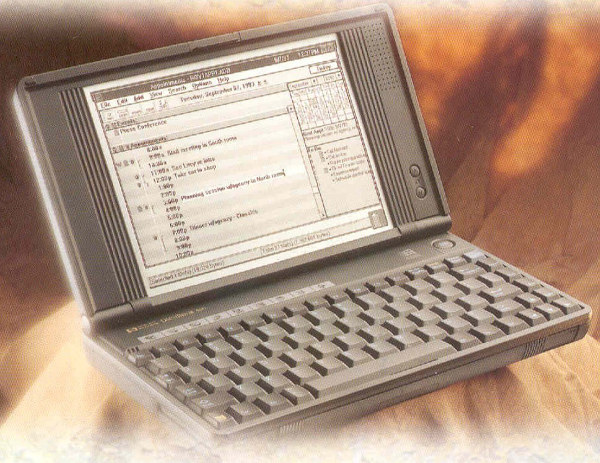Hewlett Packard Omnibook 430 Details and specs
Hewlett Packard Omnibook 430 (OB430)

About this machine:
The Hewlett Packard Omnibook 430 is exactly the same as the Omnibook 425 (besides the ROM, RAM and HDD), so since i hate repeating myself I ask you to read the article about the OB425 if you haven't already done so. OK, the difference is the ROM? Doesn't sound interesting you may think, so why make a different model out of it anyways? The bad news first: You don't get Word and Excel (Bummer!). The even worse news: You won't even get a recovery option. So if you ever blew your installation of Windows you'll have to fumble yourself or live without it. Why HP made that is beyond my understanding. Actually the OB430 was quite a lot cheaper than the 425 (200 Dollar less and they gave you the bigger 105MB HDD instead of 40MB plus a 4MB RAM extension), so my guess is that it was cheaper to make a smaller ROM card and they also saved for not needing to license Word and Excel. Biggest problem here is that without awesome knowledge and help you probably won't ever get all the drivers and service appz running (Like HP Power management, etc). The good news is that this reduced ROM card will let you install whatever you want, even Windows 95 or Linux. In some old specs listing the 430 was listed with 6MB ROM and the 425 was listed with 4MB ROM. I have kept these infos here, but maybe they accidentially swapped these values since obviously the OB430 would need less ROM due to the missing Windows, word and excel recovery option... Well the OB430 supposedly had 4MB fixed RAM built-in and the ROM also supports 105MB PCMCIA Type II HDDs although i had no problems running much larger PCMCIA flash cards.
Specs:
CPU: Cyrix 486SLC/e @ 25 MHz
Graphics: Monochrome VGA
Display: 640 x 480 monochrome STN , 16 grey scales, 9 inch
Memory (RAM): 4 MB (Can be extended up to 8MB with proprietary RAM extensions)
ROM (Software): 6 MB
I/O ports: RS232 Serial , 4 x PCMCIA 2.0 Type 2 slot (1 slot lost due to necessary ROM card), Infrared (115K bi-directional), Parallel port
Sound: PC Speaker - Piezo
Operating System: MS-DOS 5.0, Windows 3.1
Software: Typical Windows 3.1 tools, Phone Book, Appointment, File Transfer tools, HP calculator. Actually NONE if you blew your installation (No recovery option.)
Size: Length 28.2cm, Width 16.3cm, Height 3.6cm (11.1 inches x 6.4 inches x 1.4 inch)
Powered by: 4 AA batteries non-rechargable or Battery Pack or AC adaptor
Weight: 1310 gram including battery pack and Flash card
Special features: Parallel port, infrared, VGA display, Modem (optional module).
Released: February 4, 1994
Originally retailed for:: 1,599 USD (105MB HDD and 6MB RAM version). Prices "started" at 1,399 USD according to a HP ad (Supposedly less RAM and smaller HDD?).
Clone of: Not a clone. Successor model of HP Omnibook 425
Similar models: HP Omnibook 300, HP Omnibook 425
Pros:
- Excellent for easy printing on JetEye compatible HP printers
- Lets you run other Operating systems as well
- Windows 3.1 offers quite a lot of Software
- PCMCIA 2.0 Type 2 slot: Can use virtually any PCMCIA card (For Windows 3.1)
- Fully VGA compliant, so most VGA games will work (Unless they require 256 colors or more)
Cons:
- Large and heavy
- Battery life incredibly weak
- Will not let you recover the system from ROM
Collector Value:
5 of 10
Usage Value:
3 of 10
Verdict:
Give it a usability value of 10/10 if you love large and heavy subnotebooks. This is ridiculously heavy and large compared to Palmtops. Anyways if you can cope with the size, weight and weak battery life then you at least get a reliable Windows 3.1 laptop with VGA. One of the few notebooks that will let you use AA-Batteries.
Back to the Palmtop PC index
